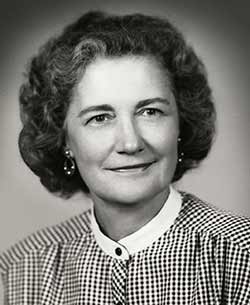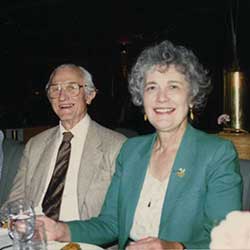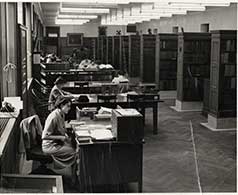An unlikely sports fan

Alice Dalligan worked with the Burton Historical Collection from 1949-88. (Image courtesy of the BHC.)
Not many people would have described Alice Dalligan as a baseball fanatic early in her 25-year career as the meticulous and dedicated manager of Detroit’s Burton Historical Collection (BHC).
She was, after all, in charge of one of the nation’s most extensive and impressive historical collections, located at the stately main branch of the Detroit Public Library on Woodward Avenue. Thousands of items dealing with important events reside at this massive archive.
The scholarly Dalligan was drawn to bookish topics — early French and British Detroit, the American Revolution, and so on. She knew little about baseball and did not follow it.
But then, in 1966, baseball and history converged for her. Then-Detroit Tigers’ play-by-play announcer Ernie Harwell, who became a legend in his own right, owned a massive collection of vintage baseball artifacts. By massive, we mean 2,000 volumes, along with boxes of photos dating back to the 1800s, phonograph records, bats, gloves, and mementos of all kinds. Any archivist would relish such an acquisition.
Play ball
Dalligan, then curator of manuscripts, acted quickly once she heard news of this trove. The 1800s? Phonograph records? Old photos? That’s not baseball. That’s history. She went to work.
Before long, Harwell announced his decision to donate his baseball treasures to the BHC. A 1966 newspaper photograph (above) shows an oh-so-young and dark-haired Harwell, Dalligan, and then-third baseman Steve Boros holding the bat of former Tigers’ great Jim Delahanty, who played for the team from1909-12.
Thereafter, as Dalligan catalogued and studied the materials, she became, well, a baseball nut. In fact, as one 1968 article described, she challenged Cooperstown as the supposed birthplace of baseball in 1839.
“Look, a facsimile of a pocket book on children’s games printed in 1787,” she said. “This page is on baseball and it even has a sketch to go with it.”
Not only that, she went on, “Did you know that the [Tigers] were called the ‘Detroits’ until 1896? George Stallings, the manager that year, made the players wear black and yellowish-brown striped stockings to dress them up. ‘Tigers’ became the team’s nickname and finally stuck.”
That Dalligan was soon the undisputed expert regarding early Tigers history surprised few from that point forward. That focus only mirrored her expertise with a wide array of subjects connected to the BHC, where she was a helpful, familiar face from 1949-88, when she retired.
And her reach extended far beyond Detroit, as retired librarian Jim Evenhuis noted in her 2009 obituary in the Detroit News. “She was not only an archivist, but working in genealogy and actively collecting priceless historical items in the community and throughout the nation.”
Motor City Cred

Dalligan and her husband, Carl, were married for 49 years. They met when Carl, a technical writer for General Motors, needed to do some research – and was assigned to a lovely young librarian named Alice. (Image courtesy of the BHC.)
Dalligan was born in Detroit in 1923, a descendant of Amasa Bagley, the early Michigan pioneer for whom the Detroit street is named. She grew up on the East Side and graduated from Southeastern High School. For a time, she worked for Hudson’s, the iconic downtown department store (now “loooooong gone,” as Harwell would phrase it). She earned her bachelor’s degree in education from Wayne University (now Wayne State University) in 1945 and taught history in the public schools for three years.
Dalligan enrolled at U-M and earned a master’s degree in history in 1948 and a master’s in library science in 1951. She was well-poised to begin a career in which her job was to help people feel about history the way she did. At the BHC she assisted people in genealogy research after the famous TV mini-series “Roots” aired in 1977. She helped launch the Black Genealogical Society, and supported the Polish Genealogical Society.
Dalligan encouraged people to search their attics, family records, old diaries, photographs, family Bibles, and birth certificates before showing up at her door.
“Talking to your oldest living relative is important,” she said, “even if the recollections aren’t perfect.”
Prized possessions
One great “score” came to Dalligan in 1971. It was the unpublished diary of Normand McLeod, who was “Town Major” of Detroit when the city was under British military control in 1778. The $10,000 acquisition at a Montreal auction was kept secret for a while.
“The bidding was anonymous but when it became known afterwards that we were the buyer, there was quite a commotion,” Dalligan said at the time. “A Montreal newspaper carried the headline, ‘Canadiana Going to USA.’”
But the archivist staunchly defended the BHC acquisition because it described McLeod’s activities in early Detroit.
Forward thinking

Dalligan would have worked in a setting much like this one in a reading room at the Detroit Public Library. (Image courtesy of the BHC.)
In her search for artifacts, Dalligan was thorough, not to mention creative. She once forthrightly stated, “I read the obituaries a lot. If I see the name of a prominent Detroiter, I contact the family.”
Throughout her career Dalligan belonged to several historical associations, including the U-M-based Fred Hart Williams Genealogical Society. In 1980, the Michigan Senate honored her with an official tribute. Ten years later, she was awarded the Daughters of the American Revolution’s Medal of Honor.
Despite her passion for history, Dalligan wasn’t always looking to the past. In a 1979 Detroit News article, she predicted the role technology would play in the lives of future historians.
“There may come a time when you will be able to walk in, punch some buttons, and get your genealogy,” she said. “Of course, that might take some of the fun out of it.”
Dalligan and her late husband, Carl, left a legacy gift to the BHC, part of which will be used to commemorate its 100th anniversary this year.




alan miller - 1974 (JD, MPP)
Thanks for this informative article. I was a big fan of Ernie Harwell who I met in his later years — a wonderful person, as well as a terrific baseball announcer. I’ve heard informally that the collection has unfortunately not been maintained and is not accessible to the public; you may want to check this out as I’m sure others will also be interested in this collection.
Reply
Deborah Holdship
The Harwell Collection (http://www.detroitpubliclibrary.org/content/harwell-collection) is arranged, indexed, and available to researchers 40 hours a week. Researchers can access Harwell materials by visiting the Burton Collection reading room. It is the exhibit room that is by appointment only. Further, there are many Harwell items online in the Digital Collections DPL DAMS. Hope this helps. — Editor
Reply
Deborah Evans - AB 1981, AMLS 1983
I worked as an archivist at the Burton from 1988-1995. Alice Dalligan, or “ACD” as she was known to her staff, was an accomplished scholar, a great reference librarian and genealogist, and a good supervisor who helped me learn the collection and develop effective outreach programs in oral history and manuscript collecting. I also knew her husband Carl, who volunteered at the Collection after he retired. They were wonderful people.
Dalligan and U-M alumna Margaret Ward launched the Fred Hart Williams Genealogical Society, Michigan’s first African-American genealogical society. The Society is still active and meets at the Detroit Main Library.
Reply
Karl Glenn - MM Wind Instruments, 1959; PhD Music Education, 1972
I have a letter from Mrs. Dalligan, June 19, 1979, in which she thanks me for directing the historical documents of the Cass Technical High School Music Department to the library. These items included programs, photos, newspaper clippings, etc. from the 50 years collections of Velma Froude, harp teacher, and Rodney O. Blood, instrument custodian. Mrs. Dalligan was very gracious in receiving these important items which were carefully catalogued and preserved at the Burton Historical Collection.
Reply